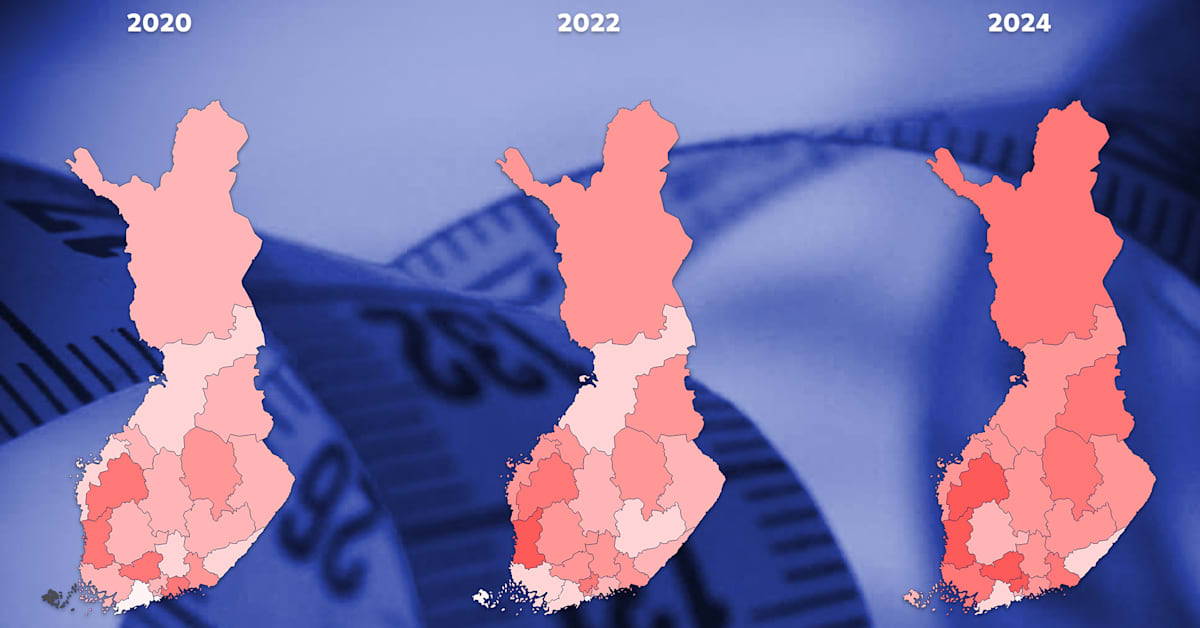Obesity is on the rise in Finland, according to latest statistics from the Finnish Institute for Health and Welfare (THL).
Last year, 24.5 percent of adults in Finland had a body mass index (BMI) of 30 or higher, reveals data from THL’s Sotkanet service — a comprehensive database of population health and welfare statistics for all Finnish municipalities, dating back to 1990.
In 2020, 22.5 percent of people in Finland were classified as significantly obese. The survey was conducted among those over 20 years old.
According to THL, a BMI of 30 is the internationally accepted threshold for health-risk obesity.
BMI threshold of 25 is already used as a criterion for obesity, but using such a low threshold leads to overweight people being classified as obese even if they are of sturdy or muscular build and do not have significant health problems.
The proportion of obese people has increased in most wellbeing services counties across Finland.
“Obesity has become more common, especially among the working-age population,” said Päivi Mäki, THL’s Development Manager, Lifestyles and Living Environment.
The maps in the image show the proportion of obese people in welfare regions in 2020, 2022 and 2024. The redder the area, the higher the proportion of obese people in the population.
South Ostrobothnia leads obesity statistics
In 2024, the highest obesity rate was in the South Ostrobothnia welfare area, where just over 30 percent of the population was obese — an increase of nearly three percentage points since 2020.
The largest rises in obesity rates occurred in the welfare areas of Northern Ostrobothnia, Lapland, and Central Uusimaa. In these areas, the proportion of obese people grew by more than five percentage points over four years, reaching around 26–28 percent last year.
Helsinki recorded the lowest obesity rates in 2020, 2022, and 2024, with the rate dropping to around 17 percent last year. The figure was similar four years earlier, despite a brief increase to just over 19 percent in 2022.
Slight decreases of less than one percentage point over four years were also seen in the welfare areas of Eastern Uusimaa, Pirkanmaa, and South Karelia, where obesity affects about 21–26 percent of the population.
More physical activity in urban areas
According to THL’s Päivi Mäki, regional differences in obesity rates can partly be explained by the easier access to physical activity in larger cities.
Cities offer better opportunities for walking, cycling, and using public transport instead of driving door-to-door. There are also more organised sports and exercise activities available.
“At the same time, we know that lifestyle habits are linked to education levels, which also vary between regions,” Mäki added.
Policy change needed
Mäki emphasises that the purpose of the statistics is not to blame individuals struggling with obesity. Instead, the goal is to encourage policymakers to implement measures that can halt the rise of obesity.
Obesity is known to be linked to several serious diseases, including type 2 diabetes, coronary artery disease, and fatty liver disease, she explains.
A recent Finnish study published in BMC Public Health found that overweight individuals generate significantly higher costs for society compared to those with a normal weight.
Mäki hopes harmful taxes could be introduced to raise prices on foods high in fat and sugar. Earlier this year, the Finnish government had abandoned its much-debated plans to raise VAT on sweets and chocolate.
Mäki also supports stricter marketing restrictions on unhealthy foods as an effective measure.
She noted that while Finland has new guidelines for marketing food to children, Norway has a law banning the marketing of unhealthy foods to anyone under 18, and Denmark is planning similar legislation.
Comments on this item have been closed.
